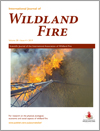International Journal of Wildland Fire
Volume 28
Number 4 2019
Leadership is a critical component of the safety and effectiveness of wildland firefighters. The aim of this research was to determine the viability of a self-rated leadership scale that measures what have been found to be essential leadership qualities in wildland fire. Findings revealed that the average leader may lack key components that exceptional leaders exhibit regarding compassion and care towards crewmembers.
What approaches do we have to help ensure we are working towards inclusive, scale-appropriate solutions for greater social and ecological resilience to wildfire response? Using network concepts and risk co-management framing, we propose a method for measuring and evaluating wildfire response that helps bridge scales and facilitate communication.
This investigation addressed the effects of a proprietary flame-retardant modacrylic undergarment on accumulation of heat while wearing wildland firefighter flame-resistant meta-aramid blend pants and shirt and exercising in a hot environment. We found the synthetic undergarment resulted in greater physiological strain compared with a cotton undergarment.
Fire is a necessary ecosystem process in many biomes and is best viewed as a natural disturbance that is beneficial to ecosystem functioning. However, anthropogenically driven changes in fire frequency, fire pattern, fuels consumed and fire intensity constitute perturbations that greatly disrupt natural disturbance cycles.
Wildfires are among the most significant natural disturbances that forests face. Here, we show that wildfires are capable of significantly decreasing the local-scale spatial heterogeneity of pine forests through changes in the spatial variability of their different components.
Analyses of relationships among flammability attributes showed that slow leaf ignitibility was correlated with long leaf burning sustainability, and vice versa. Low leaf combustibility was related to short leaf sustainability. Low overall leaf flammability was related to small leaf area, high leaf mass per area and high leaf water content.
The FireFlux II field experiment was aimed at understanding how fire-atmosphere interactions affect fire spread. The experimental design was guided by the use of a coupled fire-atmosphere model that helped determine instrument placement. The experiment collected a suite of micrometeorological, air chemistry, fuels, and fire behavior data that will be useful for both model evaluation and future research.





